Camp Haven - Whistling Straits History
Before Whistling Straits, there was Camp Haven
Situated along the western shore of Lake Michigan, just a bit north of Sheboygan in the township of Mosel is a tiny burg called Haven. Settled by German immigrants from the Moselle Region, the area was originally known as Seven Mile Creek.
Until the late 1940s, the area was strictly farmland, but because of its remote location, buffered by 118 miles of water to the east toward Michigan, it proved a suitable site for a military training facility. For a decade, from 1949 to 1959, it would be home to Camp Haven.
The crux of air defense is the detection and subsequent destruction of enemy aircraft and armaments. The earliest known use of anti-aircraft weapons took place in 1870 during the Franco-Prussian War. After the French were routed by Bismarck’s troops at Sedan, France, the city of Paris was besieged. Communication was attempted with French troops outside the city via balloon, but, German spoiler, Gustav Krupp mounted a 1-pound gun, the equivalent of a 37mm, on top of a horse-drawn carriage for the purpose of shooting down those balloons.

Troops came to Camp Haven from throughout the Midwest to train. The 109th AAA Brigade from Chicago trained in August 1949, 800 men strong, for coastal defense. It was the largest group of the year. The Lafayette, Indiana Journal and Courier published its annual reserve training schedule, and in 1952 had men from the 13-state Fifty Army area journeying to Camp Haven to train. The Belleville, Kansas National Guard, newly formed in 1950, sent its fourteen enlisted men and two officers to Camp Haven on its maiden training session. Their two weeks in August were spent training on the .50 cal and 40MM guns.

Most of the guns were trained on targets towed by planes over Lake Michigan, usually twin-engine bombers pulling long bags called target sleeves that trailed a couple hundred yards behind the aircraft. Sometimes radio-controlled drones pulled targets. Rookie gun crews firing live shells at planes and drones over the lake sometimes missed the targets. Planes returned with holes in the fuselage, targets plummeted into the water and drones parachuted downward where they were recovered on land or sank to the lake's bottom. For safety, no-fly and no-sail zones were instituted during target practice. After the camp was fully operational, B-26 bombers were used to tow large targets several hundred yards behind the plane, as firing targets for the 40mm and larger anti-aircraft guns.
The facility was quite a tourist attraction in the area. Public parking had room for 1,000 cars was provided for the public to observe the firing of the guns. Boy Scouts took charge of the area on days when there was firing. They also operated concession stands. Nearby poultry farms and hatcheries were concerned that the firing of these large guns so close to the farms might affect the mammoth incubators. It seems the vibrations did not adversely affect the quality of the operations.
Other concerns included the unpredictable landing of radio controlled robot planes anywhere in the area when the parachutes opened. The parachutes on the planes would open after they were hit by gunfire, or they could be landed by radio controlled devices. The targets were heavily weighted, and these large weights frequently turned up in grain and hay fields. One of the weights went through a farmer’s granary roof while they were working inside. The neighbors never quite knew where anything would land after the parachutes deployed. Most of the pieces were picked up by the Army, but some ended up in the woods or in the lake– those pieces became souvenirs for the locals.
Kohler Co. purchased the property in 1995 and built its world-class links course, Whistling Straits, which opened to the public in 1998. But, for a decade, thousands of young men enjoyed two weeks each summer at what they called Camp "Heaven," the most beautiful camp in the world (according to the soldiers) while they fulfilled their reserve duty.
Beth Dippel is executive director of the Sheboygan County Historical Research Center.

